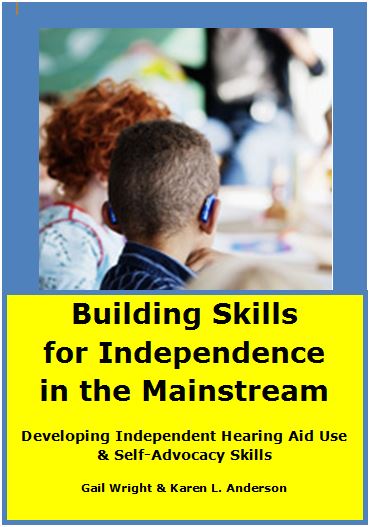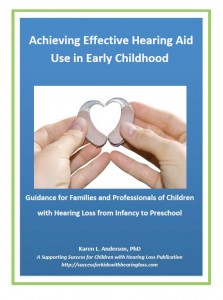Related Products
For Parents
Related Teacher Tools Takeout Items
Brain On? Hearing Device Monitoring is Necessary for Access to Education
 Lecturer Dr. Carol Flexer emphasizes how hearing loss is about the brain, not the ears. Hearing devices are needed to activate the brain and to access spoken communication for learning. For children who are hard of hearing, we need to get them through the ‘doorway’ of hearing loss, so information will get to the brain. Any ‘doorway obstruction’ interferes with auditory information reaching the brain. All hearing devices are designed to break through the doorway to get information to the brain.
Lecturer Dr. Carol Flexer emphasizes how hearing loss is about the brain, not the ears. Hearing devices are needed to activate the brain and to access spoken communication for learning. For children who are hard of hearing, we need to get them through the ‘doorway’ of hearing loss, so information will get to the brain. Any ‘doorway obstruction’ interferes with auditory information reaching the brain. All hearing devices are designed to break through the doorway to get information to the brain.
Being closer to the person talking will help the listener with hearing loss to hear more loudly and clearly. Hearing aids amplify all sound and make it seem louder and clearer at ear level for persons with hearing loss, but never ‘corrects’ hearing to a normal hearing level. They are designed to work best in picking up speech within 3’ to 6’ and amplifying it to an optimal level for hearing speech. Therefore, students with hearing loss have smaller ‘listening bubbles’ or shorter listening ranges than their typically hearing peers.

If a student with hearing aids has two dead batteries, then there is a substantial ‘doorway’ obstruction to him being able to perceive speech clearly enough to understand. Imagine a child attending class each day, but instead of sitting within the classroom, the student is required to stand outside the room and look in. Is it fair to expect him to learn at the rate of class peers when he does not have the same access to instruction? Because students seem to ‘hear’ the teacher, the impact of the hearing loss significantly reducing comprehension of what is said is very often misunderstood and minimized.
Hearing aids and FM/DM systems do not restore normal hearing, but they DO provide much improved access to verbal communication that would otherwise be auditorilly impossible to the child with hearing loss. The Americans with Disabilities Act2 requires that schools ensure that communication for students who are deaf and hard of hearing are as effective as communication for others through the provision of appropriate aids and services affording an equal opportunity to obtain the same result, to gain the same benefit, or to reach the same level of achievement as that provided to others, to participate in and enjoy the benefits of the district’s services, programs, and activities.
It is a cruel reality that 50% of children’s hearing aids malfunction on any given day1. In the US, IDEA specifies3 for children with IEPs, schools must ensure that the hearing devices worn by students with hearing loss are functioning. This requirement underscores the value of working hearing devices and their necessity if a student with hearing loss is to receive a free and appropriate public education, while the ADA focuses on the discriminatory nature of denying full access to classroom communication. With an effective hearing aid monitoring program in place hearing aid malfunction rates can drop to less than 1%1.
IDEA Sec. 300.113. (a) Each public agency must ensure that hearing aids worn in school by children with hearing impairments, including deafness, are functioning properly. (b) (1) Each public agency must ensure that the external components of surgically implanted medical devices are functioning properly.3
Although the law provides no specifics on who, how or how often hearing device monitoring will occur, there is clear intent that the school bears the responsibility to ensure that this monitoring occurs. This need for monitoring and data gathering was reinforced by the outcome of a 2015 court case4 that ruled that a school violated the IDEA record keeping clause (34 CFR 76.731 ) by not keeping a daily log of whether or not the student was provided daily access to the FM/DM system required by the IEP, and if the student used the FM/DM system each day.
In order to verify that the hearing device monitoring activity has occurred, the school needs to have a record of data that provides evidence of hearing device monitoring, including the daily presence and use of the FM/DM system if this communication access accommodation is included on the IEP.
Checklist for Monitoring Responsibilities. Do You/Does Your School District:
1. Include teaching hearing aid independence skills to students as a goal on the IEP or as part of ADA accommodations on the 504 Plan. Hearing devices can malfunction at any time. ONLY the student – with training – is able to immediately identify when a problem arises, and is in the best position to troubleshoot the device and/or request assistance.5 See SEAM skill hierarchy.
2. Have administration knowledge and support of the legal requirement to perform regular monitoring and necessary data collection. Without clear support from the principal, classroom teachers often view hearing aid monitoring as a ‘good thing to do if they have time’ rather than a required activity.
 3. Require that a teacher of the deaf/hard of hearing or educational audiologist meet with classroom teachers and provide instruction in how to monitor hearing device function, including involving the student in monitoring, and delineate expectations for necessary data gathering.
3. Require that a teacher of the deaf/hard of hearing or educational audiologist meet with classroom teachers and provide instruction in how to monitor hearing device function, including involving the student in monitoring, and delineate expectations for necessary data gathering.
4. Provide clear expectations for data collection processes/forms to be used, how often data needs to be collected (i.e., daily), where it needs to be kept, and who is ultimately responsible for ensuring that monitoring and data collection occurs.
What about students who don’t use their hearing devices?
While it may seem funny to turn to a child not wearing their hearing aids and say, “Your brain is in your pocket! Oh no!” it is true that about 25% of students do not (consistently) use their hearing aids6. Rejection of hearing aids can be due to lack of support from home. If the family is not supportive of the child using hearing aids, the student may feel as though they are being disloyal to what parents want by wearing their hearing aids at school. If the family does not want amplification to be used, it should not be included on the IEP and there needs to be a clear understanding of reduced academic achievement expectations and risk for social issues. Children can often reject their hearing aids when malfunction issues frequently occur as they learn they cannot rely on hearing better via the technology. Instruction in hearing aid use, monitoring, and troubleshooting is necessary for equal access to education. Finally, as students enter 3rd grade and beyond, having no preparation for resilience to teasing by peers too often results in students rejecting amplification secondary to social rejection concerns, even if they know that the amplification is important for learning. Most students with hearing loss are in their neighborhood school with no other peers who use hearing devices. Developing an identity as a person with hearing loss is not possible without feeling a part of a group of okay kids who happen to have hearing loss and use hearing devices. The direct involvement of a teacher of the deaf/hard of hearing to instruct students in self-advocacy skills and connect them to similar peers is needed if rejection of hearing devices due to social reasons is to be minimized. Refer here for more information on this intervention.
References
1. Langan, L. & Blair, J.C. (2000). “Can You Hear Me?” A Longitudinal Study of Hearing Aid Monitoring in the Classroom. Journal of Educational Audiology (5), 34-36.
2. Summary of ADA information related to students with hearing loss.
3. IDEA Sec. 300.113. (a) Supporting hearing aid monitoring (b) (1) Supporting cochlear implant processor monitoring.
4. Detroit City School District., 115LRP 31115 (SEA MI 06/12/15). Written summary of court case findings.
5. Instructional materials for 43 separate goals for hearing device independence can be found in Building Skills for Independence in the Mainstream.
6. 2017 Supporting Success for Children with Hearing Loss Survey: Children Rejecting Hearing Devices: Who, Why, When? Findings for 88 respondents representing a combined caseload of 1863 students.





